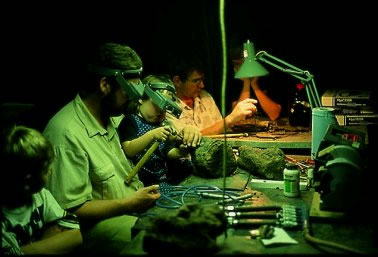Starting at bedrock the story of the Great Karoo goes back 270 million years to when the central part of' South Africa was a low-lying basin ringed by high lying land and covered by a thick mantle of slow-moving ice. With the coming of a warmer, wetter climate an enormously long period of alternating low and high rainfall seasons settled over South Africa.
 This period saw the development of a luxurious plant life and the appearance of now long-extinct animals. With the passing of millions of years sand, mud and clay, often containing the fossil remains of animals and plants, were pressured and hardened into a series of rock layers, or strata, thousands of metres thick. The countryside formed from these deposits is today known in the Cape as The Karoo, while the series as a whole is known to geologists as the Karoo System.
This period saw the development of a luxurious plant life and the appearance of now long-extinct animals. With the passing of millions of years sand, mud and clay, often containing the fossil remains of animals and plants, were pressured and hardened into a series of rock layers, or strata, thousands of metres thick. The countryside formed from these deposits is today known in the Cape as The Karoo, while the series as a whole is known to geologists as the Karoo System.
This, in turn, is divided into several series that are, from oldest to youngest, the Dwyka, the Ecca, the Beaufort and the Stormberg series.
On the left is a photo of a Diictodon fossil (reptile-like mammal) found in the Karoo National Park. This fossil is approximately 240 million years old. (Dr F Durand)
It is from the beds of the younger geological series that have come the fascinating fossils, which have led to the Karoo's recognition as one of the biggest and most important fossil deposits in the world.

Painstaking pre-historical detective work done by such famed fossickers as the late Dr Robert Broom has vividly repopulated the dim distant Karoo with the grim and grotesque monsters which lumbered, grazed and fought in its primeval marshlands and rivers; animals such as the Pareiasaurus, a fearsome-looking cross between a hippopotamus and a crocodile which was preyed upon by the even more hideous titanosuchids, therocephalians and the smaller gorgonopsians.
It is strange today to think of the Karoo's lonely landscape echoing with the shrieks and bellows of battling dinosaurs, stranger to realise that while these scaly monsters were fighting for supremacy a new type of animal, no larger than a rat, had appeared on the Karoo scene to announce the beginning of the first true mammals.
The Karoo's evolutionary scenario had a dramatic curtain when the semi-desert habitat experienced cataclysmic volcanic eruptions, which poured vast rivers of molten lava over the countryside, destroying all animal and plant life. At the end of this volcanic activity a period of erosion started which gradually stripped away land surfaces to expose the entire Karoo succession - a petrified showcase of entombed plants and animals - in a process that is still going on.
For the visitor this area offers a treasure chest of information. Various tour operators specialise in fossil tours.